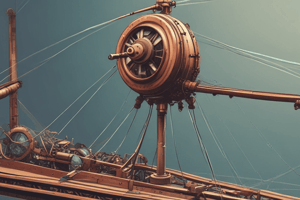Podcast
Questions and Answers
Which term refers to the load divided by the effort in a machine?
Which term refers to the load divided by the effort in a machine?
- Line of gravity
- Centre of gravity
- Mechanical advantage (correct)
- Base of support
What are the four ways in which machines function in the body?
What are the four ways in which machines function in the body?
- Balance multiple forces, enhance speed of movement, alter direction of applied force, increase mechanical advantage
- Balance multiple forces, enhance force, alter direction of applied force, increase mechanical advantage
- Balance multiple forces, enhance range of motion, enhance speed of movement, increase mechanical advantage
- Balance multiple forces, enhance range of motion, alter direction of applied force, increase mechanical advantage (correct)
What is the formula for mechanical advantage?
What is the formula for mechanical advantage?
- Mechanical advantage = load - effort
- Mechanical advantage = effort/load
- Mechanical advantage = load + effort
- Mechanical advantage = load/effort (correct)
Which principle refers to the point at which the entire weight of an object is considered to act?
Which principle refers to the point at which the entire weight of an object is considered to act?
What are some examples of machines in the musculoskeletal system?
What are some examples of machines in the musculoskeletal system?
Flashcards are hidden until you start studying
Study Notes
Mechanical Concepts
- Load divided by effort in a machine: The term "Mechanical Advantage" describes this ratio, indicating how much a machine amplifies an input force.
Functionality of Machines in the Body
- Four ways machines function in the body:
- Change the direction of force, allowing movement with less physical effort.
- Increase the distance and speed of movement, benefiting activities like running or throwing.
- Provide a mechanical advantage, reducing the effort needed to perform a task.
- Transform linear motion into rotational motion, enabling joint movement.
Mechanical Advantage Formula
- Formula: Mechanical Advantage (MA) = Load (Resistance) / Effort (Input force). This formula helps assess a machine's efficiency in reducing the necessary input force compared to the output load.
Center of Gravity Principle
- Point of action for weight: The term "Center of Gravity" refers to the specific point at which the entire weight of an object is considered to act, influencing stability and movement.
Musculoskeletal System Machines
- Examples of machines in the musculoskeletal system:
- Levers formed by bones and joints, enabling various movements.
- Muscles acting as forces, creating moments around joints.
- Tendons transferring muscle contractions to bone, facilitating motion.
- The use of pulleys in tendons that change the direction of muscle action, optimizing movement efficiency.
Studying That Suits You
Use AI to generate personalized quizzes and flashcards to suit your learning preferences.




